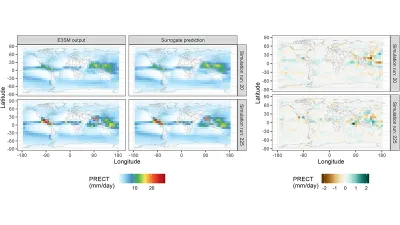Autocalibration of the E3SM Atmosphere Model Improves Model Fidelity
Earth Systems Models are unable to resolve all the processes affecting climate, so important unresolved processes are represented by parameterizations. The traditional approach is to hand-tune these parameters using expert knowledge, a time-consuming process that involves matching climate model output to observational data as closely as possible.
We demonstrate a method to calibrate ESMs in an automated way using machine learning that is significantly faster and performs better in many cases than the hand-tuning process of ESMs. This method is intended to work alone or in tandem with expert tuning. Improvements in model tuning can contribute to improvements in model predictions of the past, present, and future, and a better understanding of uncertainty.
The systems governing the atmosphere and other physical processes on Earth are complex, and climate scientists use Earth Systems Models (ESMs) based on physical and computational representations of these processes to create simulations that mimic the behavior of Earth's climate. Since ESMs are defined at a lower resolution than some processes require, parameters are introduced to address the uncertainty in the approximation. The traditional approach is to hand‐tune these parameters using expert knowledge, a time‐consuming process that involves matching climate model output to observational data on Earth, as closely as possible. Instead, we introduce an alternative “automated calibration” framework that chooses such parameters automatically and in a fraction of the time. This is done by building a very fast
machine‐learning‐based substitute (surrogate) for the ESM to predict variability in the climatology for 11 different spatial fields over four seasons and then using this surrogate to search for the parameters that best match climate observations. We apply our framework to the atmospheric component of the Department of Energy's Energy Exascale Earth System Model (E3SM) version 2, and demonstrate an improvement of 2.7% in root‐mean‐squared‐error on average across the different variables and seasons, compared to the hand‐tuned solution. This flexible, robust, and automated approach is straightforward to implement, and we demonstrate that the resulting model output matches present-day climate observations as well or better than the corresponding output from expert-tuned parameter values while considering high‐dimensional output and operating in a fraction of the time.

